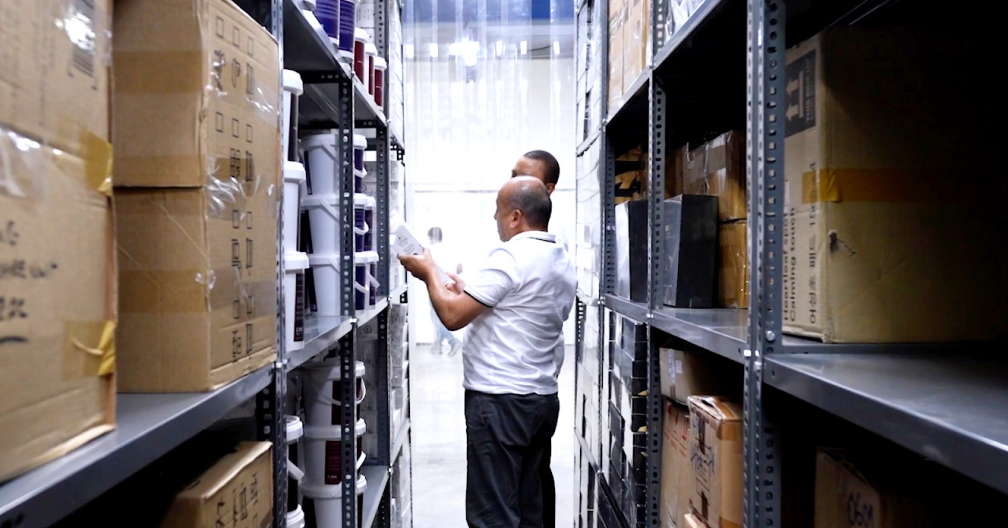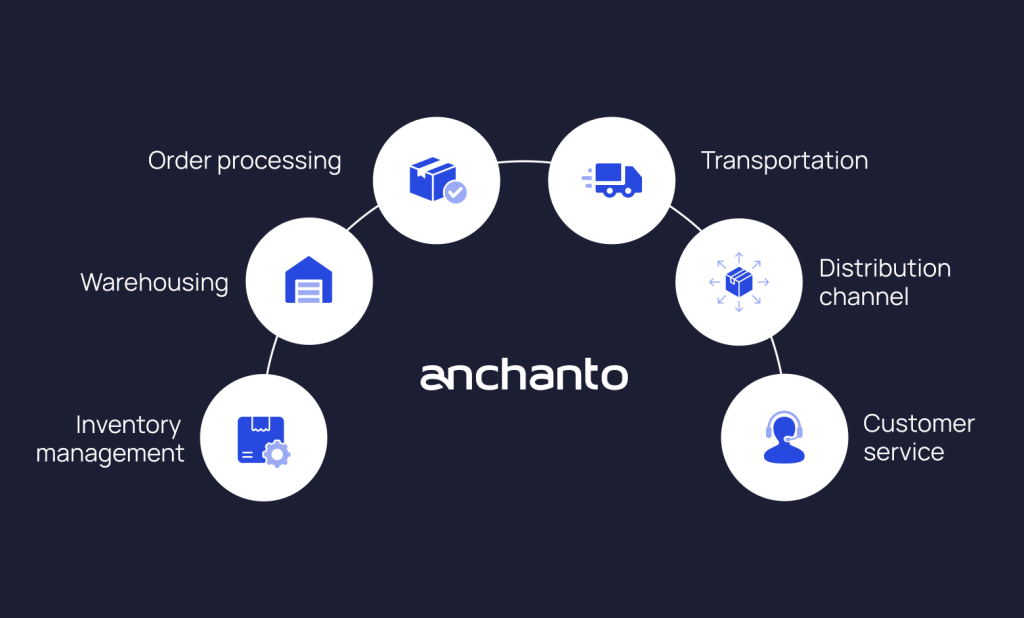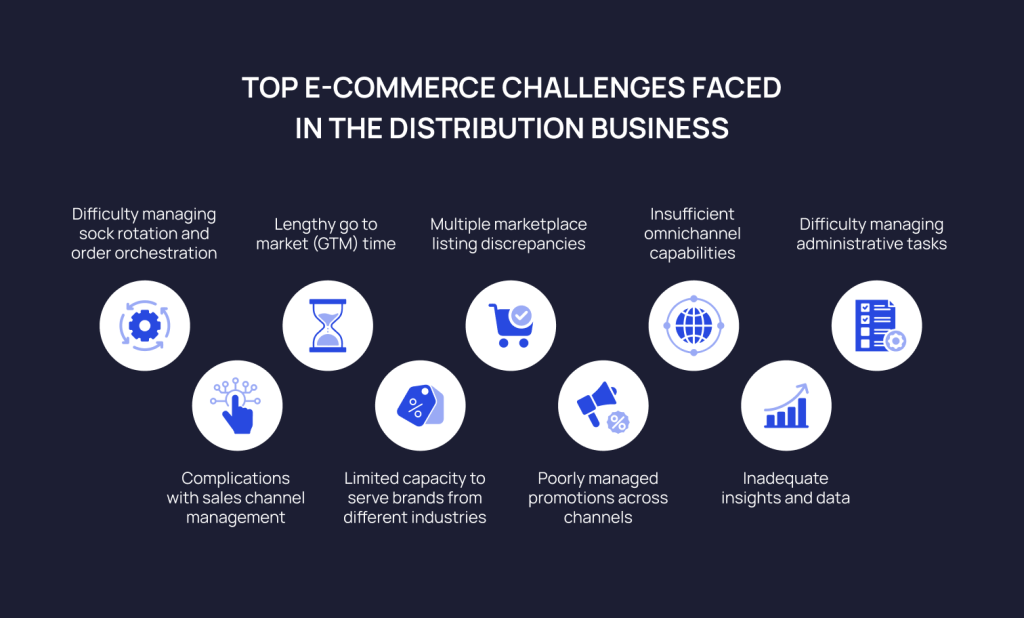Distribution Management: Definition, Benefits and Challenges
Blogs
Distribution management is the backbone of any product-based business. From manufacturers and brand owners to wholesalers and 3PL providers, every business in the supply chain depends on well-executed distribution to meet customer expectations and protect profit margins.
Consider this: a beauty brand launches a flash sale across multiple marketplaces in Southeast Asia. Orders spike overnight, but without a streamlined distribution system in place, stockouts occur in some countries, delayed deliveries in others, and customer complaints flood in. It’s a missed opportunity that could’ve been avoided with a strong retail and distribution management strategy.
In this article, we’ll break down what distribution management, why it matters for business success, and the various types of distribution management businesses can adopt to stay competitive in today’s fast-moving market. You’ll also discover how to address common challenges and leverage technology to build a more agile, profitable operation. So whether you’re running an e-commerce brand, a logistics operation, or scaling across multiple marketplaces, this guide will help you optimize distribution for greater efficiency and growth.
What is Distribution Management?
Distribution management refers to the process that covers everything involved in moving products from a supplier or manufacturer to the customer.
It’s an umbrella term that includes packaging, inventory, warehousing, supply chain, and logistics. Think of it as the “traffic controller,” directing every shipment across your supply chain to the right route at the right time so there’s no chaos or downtime.
For distributors and wholesalers, it’s the backbone of your operation. Profit margins usually depend on how quickly goods can be turned over. Hence, the faster you sell, the more revenue you bring in while maintaining customer satisfaction.
Ultimately, the goal of effective distribution management is to ensure products reach their destination while reducing shipping costs and delivery times to maximize efficiency and profitability.

Why is Distribution Management Important?
Beyond simply moving products, today’s distribution management is about leveraging market data, keeping deliveries on schedule and in optimal condition.
Done well, a sales and distribution management strategy can transform your operations by helping you fulfill orders faster, stay on top of inventory levels, and quickly adapt to market changes.
As a result, you can expect smoother day-to-day activities, lower costs, and a strong competitive advantage.
Here are four powerful ways distribution management directly impacts your business success:
- Lower costs: By optimizing storage, transportation, and handling processes, you’ll lower operational waste and reduce overhead.
Example: A furniture distributor partnering with a 3PL warehouse can consolidate shipments from multiple sales channels into fewer deliveries. This cuts transportation costs, shortens delivery routes, and maximizes warehouse space.
- Revenue growth: Having products available where and when customers want them leads to more sales opportunities and higher customer satisfaction.
Example: An online electronics store that keeps popular gadgets in stock (and monitors inventory in real-time) sees fewer missed sales—ultimately boosting revenue and repeat business.
- Market competitiveness: Fast and reliable delivery helps your brand stand out, particularly in markets where timing is everything.
Example: A 3PL specializing in last-mile delivery enables businesses to offer same-day or next-day shipping. This convenience not only meets modern customer expectations but also positions the business ahead of slower competitors.
- Supply chain optimization: Distribution management is the linchpin of supply chain optimization, helping you adapt quickly to market shifts and disruptions by providing real-time data on inventory and demand.
Example: A business can redirect shipments to take advantage of local demand, helping to avoid stockouts and missed sales. For example, if one warehouse experiences a sudden increase in orders for a new skincare line, stock can be rerouted from a slower-moving region. This approach prevents lost revenue, keeps customers satisfied, and ultimately reduces costs while supporting a more agile operation overall.
Distribution Management vs. Logistics
While often used interchangeably, distribution management and logistics have distinct differences:
- Distribution management takes a higher-level view of getting products from suppliers to customers, making big-picture decisions about which channels to use, how much market coverage you need, and the type of customer service you want to provide. It’s about aligning those strategic moves with your overall business goals and market demands.
- Logistics, on the other hand, is a part of distribution management that zeroes in on the physical movement and storage of goods—everything from transportation to warehousing and inventory control.
If distribution management decides whether to sell directly to consumers (D2C) or through retail partners, logistics determines how to move products through those chosen channels.
Understanding this distinction is essential for businesses aiming to optimize their supply chain operations effectively.
Here’s a quick overview of the differences between distribution management and logistics:
| Aspect | Distribution Management | Logistics |
| Scope | Strategic and overarching | Tactical and operational |
| Focus | Channel selection, customer service levels, market coverage | Transportation, warehousing, inventory control |
| Goal | Align distribution strategy with business objectives | Ensure timely, cost-effective movement of goods |
| Decisions Involved | D2C vs. retail channels, regional expansion, service SLAs | Route planning, carrier selection, warehouse operations |
| Relationship to Each Other | Includes logistics as a component | Functions within the broader distribution strategy |
Understanding this distinction is essential if your business is aiming to optimize supply chain operations effectively.
Types of Distribution Management Strategies
Distribution management is all about the efficiency of the processes that support your distribution strategy. It’s the behind-the-scenes work that ensures your products get from point A to point B in the most effective way.
This includes managing inventory, storage, shipping, and logistics, ensuring that the flow of goods supports the overall distribution strategy of your business. A well-run distribution management system is essential for executing the right distribution strategy to reach your target market.
Now that we’ve set the stage, let’s dive into the five main types of distribution management strategies and how distribution management plays a crucial role in each.
1. Intensive
- Think of products like Lay’s potato chips, they’reavailable everywhere, from supermarkets to vending machines.
- The goal here is to maximize exposure and accessibility by getting the product into as many outlets as possible.
- This strategy works best for frequently purchased, low-cost items with broad appeal.
2. Selective
- This strategy narrows your retail presence to specific outlets that align with your brand image.
- Companies like Apple use selective distribution, only allowing authorized dealers and selected stores to sell their products.
- It’s ideal for mid-range to premium products where quality service and the right atmosphere matter, balancing availability with brand control.
3. Exclusive
- With exclusive distribution, availability is limited to a few high-end outlets, creating a sense of prestige.
- Luxury brands like IWC Schaffhausen or Hermès typically use this strategy, ensuring their products are only available in flagship boutiques or dedicated showrooms.
- By keeping the product scarce, they maintain exclusivity and justify higher prices while offering top-tier customer service.
4. Direct-to-Consumer (D2C) Distribution
- This approach skips intermediaries entirely. Instead, products go straight from the brand to the end customer, usually via an e-commerce website or branded marketplace store.
- Companies like Glossier or Gymshark built their business on D2C strategies, using digital platforms to control the customer journey and gather data insights.
- D2C is ideal for brands that want more ownership over their brand experience, pricing, and customer relationships.
5. Hybrid Distribution
- Hybrid strategies blend elements of D2C and traditional retail/wholesale models, offering flexibility across markets.
- For instance, a skincare brand might sell directly via its online store, while also working with online marketplaces and physical retail partners in other countries.
- This model supports rapid market expansion and lets businesses tailor their approach based on region, channel performance, or customer preferences.
Key Components of a Distribution Management Strategy
A distribution management strategy is essential for attracting customers and staying profitable. It blends commercial (sales) and physical (logistics) processes, integrating various key functions like customer service, shipping, inventory control, and market intelligence.
Here are the major components that make an effective distribution management strategy work:
1. Inventory management
- Maintain the right stock levels without running into shortages or overstocking.
- This calls for accurate forecasting and real-time tracking of product movement.
2. Warehousing
- Create strategic storage solutions to maximize available space, reduce handling times, and speed up product access.
- As e-commerce demand rises, digital warehouse management systems become more critical for high-volume B2C fulfillment—especially for warehouses and 3PL providers.
3. Order processing
- Use streamlined systems to receive, validate, and fulfill customer orders quickly and accurately.
- This covers every step from order entry to shipment confirmation.
4. Transportation
- Coordinate different shipping methods and carriers to ensure deliveries happen on time and within budget.
- This includes route planning, carrier selection, and delivery scheduling.
5. Distribution channel
- A network of businesses or intermediaries that moves products from the manufacturer to the end consumer.
- This means selecting the most efficient routes and methods to ensure timely delivery.
6. Customer service
- Provides order updates, handles inquiries, and resolves issues promptly.
- Strong customer service not only enhances satisfaction but also drives repeat business.

What are the Major Distribution Channels?
- Wholesaler
- Buys products in bulk to offer storage and large-scale distribution, relieving manufacturers of dealing with multiple small orders.
- Often passes on cost advantages to retailers, making the supply chain more efficient for high-volume or frequently replenished goods.
- Retailer
- Serves as the direct point of contact for end consumers, managing local inventory and providing in-person or online customer service.
- Collects firsthand market insights, helping manufacturers refine products and meet evolving consumer demands.
- E-commerce
- Operates round the clock, overcoming geographical limits and expanding a business’s reach to global markets.
- Tracks consumer behavior in real-time, allowing quick tweaks to product offerings, pricing, and promotions based on data.
- Distributor
- Acts as a middleman between manufacturers and retailers (or wholesalers), typically specializing in a specific industry or product line.
- Often provides warehousing, shipping, and even marketing support, helping brands streamline their operations and broaden market reach.
Role of Technology in Modern Distribution Management
The fast-paced, multichannel distribution landscape, demands technological support. Whether you’re managing multiple sales channels, working with 3PL partners, or expanding into new markets, the right tech stack can make or break your operations.
Here’s how technology transforms modern distribution management:
1. Automated order processing
Being able to automatically sync and process orders across platforms like Shopee, Lazada, and brand webstores offers various benefits. For example, it eliminates manual data entry, reduces fulfillment errors, and enables faster processing, especially during peak sales periods.
2. Real-time inventory management
There’s a real advantage to gaining visibility of stock across all warehouses, channels, and partners. This advantage translates to prevented overselling, efficiently managed stockouts, and quick responses to shifting demand.
3. Cloud-based system options
Cloud technology allows teams, partners, and clients to access real-time data from anywhere. Whether you’re onboarding new distributors or expanding into new markets, cloud access supports faster (and better-informed) decision-making, seamless collaboration, and scalability.
4. Smart routing and fulfillment logic
Advanced OMS solutions can automatically route orders to the nearest or most optimal fulfillment center based on location, inventory availability, or service-level agreements. This shortens delivery time, lowers logistics costs, and improves customer satisfaction.
5. Integrated analytics and reporting
Imagine having centralized dashboards and detailed reporting tools that track key performance metrics such as order status, return rates, and channel-specific sales performance. These insights empower you to to fine-tune operations or retail and distribution management strategies in real time.
Distribution Management Benefits for E-commerce Businesses
Distribution management can be tailored to help your e-commerce business gain a competitive edge and meet growing customer demands for quick shipping, easy returns, and a user-friendly experience.
Here’s how:
- Faster order fulfillment and delivery: A well-organized distribution strategy processes orders swiftly, reinforces brand trust, and meets expectations for rapid shipping. By implementing automated picking, efficient packing, and optimized carrier selection, delivery times can be significantly reduced.
- Better returns management and reverse logistics: Clear return policies and efficient handling—like dedicated return zones and real-time tracking—keep costs under control and maintain customer satisfaction.
- Seamless multi-channel integration: Strong distribution management aligns inventory across channels in real-time, preventing overselling or stockouts. Additionally, centralized order and inventory tracking reduces errors and creates a unified customer experience.
- Scalability during peak seasons: Sales events like 11.11, Black Friday, or major holidays can create huge spikes in orders. A flexible distribution network, complete with contingency plans and well-placed inventory, can help your business handle high-demand periods without slowing down fulfillment.
Challenges in Distribution Management
Distribution management often faces hurdles that can disrupt operations and drive up costs. Natural disasters, geopolitical tensions, and global health crises can delay shipments and break trade routes, while raw material shortages and transportation glitches add to the challenge.
Seasonal shifts, changing market trends, and economic uncertainty make it hard to balance inventory—resulting in stockouts during peaks or excess stock when sales drop.
Additionally, e-commerce distribution faces a unique set of challenges. Managing stock rotation and order orchestration across multiple online and offline channels can quickly become overwhelming.

The infographic highlights key e-commerce distribution challenges.
Without robust technology, you risk delayed orders, inaccurate stock counts, and increased manual work—which ultimately affects the customer experience.
Sales channel management also presents its own challenges. Handling varied requirements for marketplace listings, running coordinated promotions, and ensuring real-time data across all channels demands substantial resources. Inconsistent data or outdated systems can slow down go-to-market times and hurt sales performance, all while driving up operational costs.
On the administrative front, juggling returns, account management, and payment reconciliation often leads to backlogs and errors. Limited omnichannel capabilities and insufficient insights hinder quick decision-making, leaving brands frustrated.
Choosing the Right Software for Your Distribution Management Strategy
As your business expands and supply points increase, technology becomes essential for managing these challenges and processes efficiently.
Solutions like Order Management Systems (OMS) and Warehouse Management Systems (WMS) work together to centralize your inventory, execute orders flawlessly, and reduce manual errors. They ensure that stock levels across online and offline channels are accurate, orders are filled quickly, and your overall operations run efficiently.

The benefits extend beyond order processing. With advanced systems, you can automate tasks such as channel management, product listing updates, and promotions, which in turn speeds up your go-to-market timelines.
Integrating with tools like Product Information Management (PIM) and ERP systems ties everything together, from financials to inventory tracking, giving you real-time insights for better decision-making.

Businesses that invest in software and automation tools have enjoyed several advantages, including fewer errors, lower shipping and storage costs, and a growth-driven distribution management strategy.
Distribution Management Real-World Use Cases
Now that we’ve explored the strategic value of implementing OMS and WMS software, let’s look at how real businesses have put these solutions to work—and what results they’ve achieved. Here are two key case studies where e-commerce distributors used technology to their advantage, allowing them to grow and scale successfully.
1. Rurutiki – Nestlé Malaysia’s Official Distributor
From manual chaos to seamless sales operations
Rurutiki, an official distributor of Nestlé Malaysia, faced significant operational strain during high-volume sales events like 11.11. Their team was stretched thin, having to manage large volumes of orders manually. The process was both error-prone and inefficient, with their Director Corey Tan even calling it “an unforgettable experience” because it took the whole company to help out on various tasks.
However, after implementing Anchanto’s comprehensive OMS and WMS solution, Rurutiki was able to digitally manage:
- 4,700+ SKUs
- 19 e-commerce stores
- Over 10,000 orders per month
With all their inventory and orders managed centrally and in real time, the company gained complete operational visibility and significantly reduced errors during peak sales periods. What was once a manual scramble became a streamlined, scalable operation.
2. Luxasia – Omni-Distribution Platform for Beauty and Luxury Brands
Unlocking 7X growth with scalable, multi-country e-commerce distribution
Operating across 11 countries, Luxasia is a major distributor for beauty and luxury brands in Asia. Previously, their large-scale operations suffered from limited visibility, fragmented sales data, and restrictions in growth due to disconnected systems.
But that soon changed. By implementing an OMS, Luxasia was able to:
- Launch 50 brands online
- Operate across 220+ shops and e-commerce platforms
- Achieve 7X revenue growth in a single year
Perhaps most impressively, this was achieved without expanding their warehousing footprint, increasing headcount, or changing their core SAP system. With improved access to country-specific performance data, Luxasia streamlined its distribution network and unlocked seamless regional expansion.
If you’re a B2B business considering a move into the B2C space (like the e-distributors above), this shift requires more than just a new sales channel; it demands a complete rethink of your fulfillment strategy, which you can read about here.
Top Distribution Management Trends
As consumer expectations rise and supply chains grow more complex, distribution management is evolving rapidly. Businesses that want to stay competitive will need to embrace new technologies and rethink their approach to retail and distribution management, especially as digital commerce, logistics, and customer behavior continue to shift.
Here are five key trends shaping the future of distribution management:
1. Smart automation across the supply chain
Automation will go far beyond order processing. Expect to see greater use of AI and machine learning to optimize warehouse operations, demand forecasting, and route planning. Automated systems will make decisions in real time and thus, reduce human error, increase speed, and support leaner teams when it matters most.
2. Hyperlocal fulfillment and micro-warehousing
To meet demand for same-day or next-day delivery, more businesses will adopt decentralized fulfillment models. This includes setting up micro-warehouses in urban areas to move inventory closer to customers. It also allows for faster replenishment and reduced last-mile delivery costs.
3. Unified Commerce and Channel Integration
Retail and e-commerce are converging. As such, businesses will continue investing in unified distribution strategies that seamlessly connect offline stores, online marketplaces, brand websites, and social commerce. OMS solutions will play a key role in managing inventory, pricing, and promotions across these integrated ecosystems.
4. Data-driven distribution planning
Access to real-time analytics will become a non-negotiable for distribution leaders. From SKU-level demand trends to return rate analysis by region, data will drive more accurate decisions about stock allocation, warehouse placement, and channel performance. In other words, the future of distribution will be predictive, not reactive.
5. Sustainable distribution practices
Sustainability is no longer just a CSR (Corporate Social Responsibility) initiative, it’s a business priority. Currently, more companies are looking to invest in green logistics, recyclable packaging, route optimization for lower emissions, and consolidated shipping to reduce carbon footprints. Customers and partners alike will expect these practices as part of your brand promise.
Conclusion
Mastering distribution management is crucial for building an efficient and customer-first approach that keeps you ahead of competitors.
By combining best practices—like inventory optimization and strategic channel selection—with technology, data analytics, and ERP integration, you can fine-tune order fulfillment and choose the right distribution management strategy for your business, whether it’s intensive, selective, or exclusive distribution.
Leveraging the right software and systems significantly reduces errors and operating costs while increasing flexibility and scalability. These solutions allow you to respond to market shifts with clear and actionable insights, keeping your operations agile and competitive.
In short, an effective distribution management strategy creates value across your supply chain by ensuring products consistently reach customers in optimal condition, paving the way for long-term success.
For a deeper dive into e-commerce distribution challenges and solutions, check out our case studies.
Or get in touch with our experts today to learn how Anchanto can transform your distribution management strategy with innovative software solutions.
FAQs
1. What are the 4 major functions of distribution management?
The four major functions of distribution management are:
- Inventory management: Ensuring optimal stock levels across warehouses and sales channels.
- Warehousing and storage: Organizing and managing physical goods until they’re ready to ship.
- Order processing: Receiving, verifying, and fulfilling customer orders accurately.
- Transportation and delivery: Selecting carriers, planning routes, and ensuring timely delivery to customers.
Together, these functions form the backbone of efficient retail and distribution management, helping businesses deliver the right products to the right place at the right time.
2. How does distribution management differ from logistics?
While they often overlap, there’s a clear distinction:
Distribution management is the broader strategy that includes channel selection, market coverage, and customer service alignment.
Logistics is a subset of distribution management focused specifically on the storage, movement, and handling of goods.
In a nutshell, if distribution management determines the where and why, logistics handles the how.
3. What is the role of OMS in distribution management?
An Order Management System (OMS) plays a central role in modern distribution management by coordinating the flow of orders across multiple sales channels and fulfillment locations. It automates order processing, synchronizes inventory in real time, and routes orders to the most efficient warehouse or delivery partner.
OMS software is especially critical for businesses using complex or hybrid types of distribution management, such as D2C, retail, and marketplace models—all running in parallel.
4. How can I improve my distribution management process?
Improving your distribution management process starts with streamlining operations and increasing visibility. Here are a few key steps:
- Invest in technology like OMS and WMS to automate manual tasks and centralize operations.
- Optimize inventory placement to reduce delivery times and logistics costs.
- Analyze performance data to spot bottlenecks and adapt to demand changes.
- Integrate systems such as ERP, Product Information Management (PIM), and e-commerce platforms for seamless coordination across departments.
When combined, these practices support a smarter, more scalable approach to retail and distribution management.
